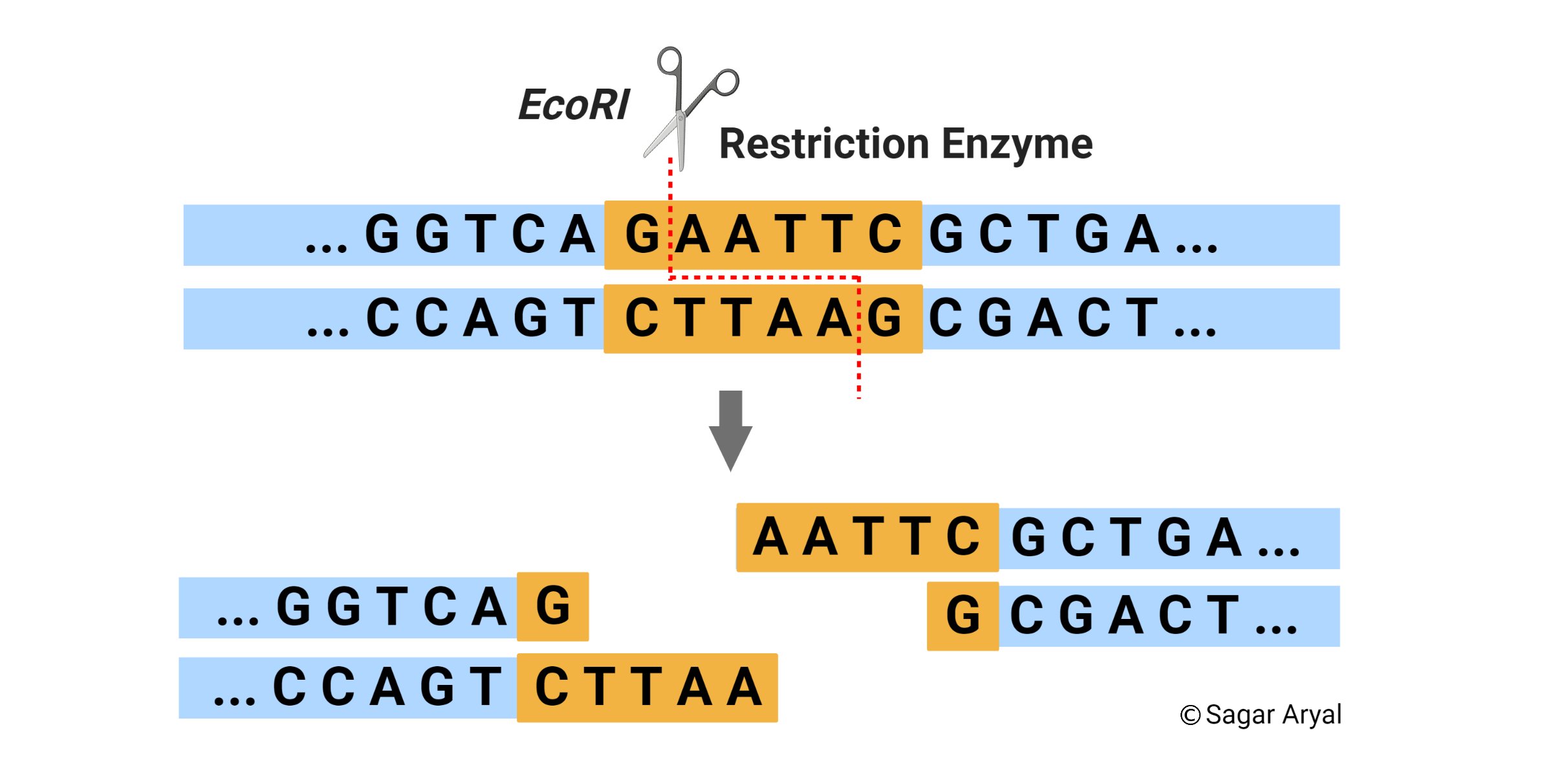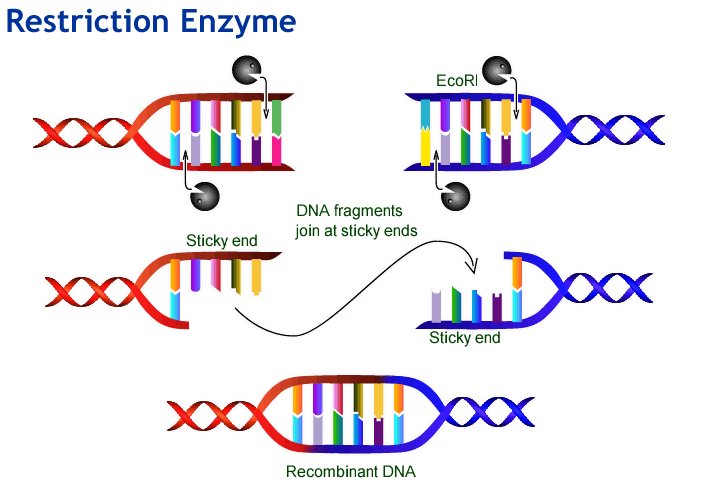Describe How Enzymes Are Used to Cut Dna
Once the endonuclease finds this sequence it halts and cuts the strand. They allow researchers to obtain desired DNA fragments from genomic DNA.

Restriction Enzyme Restriction Endonuclease
The mode of action of a template-dependent DNA polymerase.

. Use DNA ligase to produce recombinant DNA. Explain how restriction enzymes are used to cut and paste DNA into plasmids. Correct option is C Restriction endonucleases are enzymes which scan the DNA molecule for a particular nucleotide sequence.
What types of DNA sequences do they recognize. Please describe in words or pictures or both what the structure of an alpha helix is. Sticky ends of the gene and the plasmid will hydrogen bond.
Briefly describe how restriction enzymes gel electrophoresis and PCR are used in DNA fingerprinting. In order for DNA to reproduce the base pairs must be split apart. Plasmids are then removed from bacterial cells.
What kind of enzymes are used to cut DNA. Make sure to include the hydrogen bonding pattern specify between which atoms the hydrogen. The DNA of the plasmids is.
What enzymes are used to cut DNA. The discovery of enzymes that could cut and paste DNA made genetic engineering possible. Large DNA Molecules Are Cut into Fragments by Restriction Nucleases.
While there are hundreds of different restriction enzymes they all work in essentially the same way. One half of the strand is then used as a template to build a new strand of DNA. You can think of restriction enzymes as little molecular scissors that slide along the DNA and cut the sugar-phosphate backbone wherever they find their restriction site.
This article throws light upon the seven types of enzymes involved in DNA synthesis and cloning. Restriction enzymes are a type of endonucleases that can be used to cut double-stranded DNA at specific regions. An enzyme that synthesizes DNA is called a DNA polymerase and one that copies an existing DNA or RNA molecule is called a template-dependent DNA polymerase.
An enzyme is used to cut out a specific gene and the same enzyme is used to cut open a plasmid. Each enzyme has what is known as a recognition sequence or site. The seven types of enzymes are.
The figure shows how a restriction enzyme can make a cut in a circular piece of DNA and turn it. 1 Alkaline Phosphatase 2 Terminal Transferase 3 Thermo-stable DNA Polymerases 4 Bacteriophage RNA Polymerases 5 Nucleases. These are called recognition sequences.
Restriction enzymes found naturally in bacteria can be used to cut DNA fragments at specific sequences while another enzyme DNA ligase can attach or rejoin DNA fragments with complementary ends. The enzyme scans a DNA molecule looking for a particular sequence usually of four to six nucleotides. See answer 1 Best Answer.
A restriction enzyme is a DNA-cutting enzyme that recognizes specific sites in DNA. Restriction enzymes recognise specific sequences in DNA and cut the DNA at these points DNA Ligase another enzyme is used to join the two pieces of DNA together. Many restriction enzymes make staggered cuts at or near their recognition sites producing ends with a single-stranded overhang.
Thus the correct answer is option C. Other restriction enzymes like EcoRI cut through the DNA strands at nucleotides that are not exactly opposite each other. The restriction enzymes are used to cut the DNA fragments at specific sequences and DNA ligase enzymes are used to.
Restriction enzymes are endonucleases that cut DNA at specific locations called restriction sites. They are essential tools for recombinant DNA technology. SmaI is an example of a restriction enzyme that cuts straight through the DNA strands creating DNA fragments with a flat or blunt end.
Restriction enzymes have specific recognition sites. Recombinant DNA generally contains a gene of interest inserted into a vector. Once it finds this recognition sequence.
Each restriction enzyme recognizes and can attach to a certain sequence on DNA called a restriction site. This creates DNA fragments with one nucleotide strand that overhangs at the end. If two DNA molecules have matching ends they can be joined by the enzyme DNA ligase.
Helicase moves along the DNA strand unzipping the strand just as a zipper moves along. A specific enzyme is used to extract the required gene from the human chromosome. The enzyme helicase is responsible for splitting DNA along the base pairs.
Enzymes can be used to cut up and join DNA pieces together. They have molecular weight 300000 which contains SIX identical subunits. During this technique the selected DNA fragment is inserted into a plasmid the circular piece of DNA using enzymes.
Okazaki fragments are short stretches of 1000-2000 bases produced during discontinuous replication they. Restriction enzymes and DNA ligase are used in the process. In DNA fingerprinting restriction enzymes can be used to cut DNA to obtain the banding pattern of STR.
DNA cloning is the process of making multiple copies of a particular segment of DNA. They are all used in the process because restriction enzymes cut DNA at specific points gel electrophoresis separates various lengths of. Restriction endonucleases are a group of enzymes that can recognise and cut specific sequences of DNA into fragments with sticky ends.
Unlike a protein a gene does not exist as a discrete entity in cells but rather as a small region of a much longer DNA moleculeAlthough the DNA molecules in a cell can be randomly broken into small pieces by mechanical force a fragment containing a single gene in a mammalian genome would still be. The properties of restriction enzymes can be used to produce recombinant DNA molecules by cutting DNA at precise locations. Restriction enzymes are a class of enzymes that cut DNA into fragments based upon recognizing a specific sequence of nucleotides.
Restriction Enzymes Restriction enzymes also known as restriction endonucleases are enzymes that cut a DNA molecule at a particular place. DNA helicase enzyme functions Unwinds DNA. Restriction enzymes are also known as restriction endonucleases.
DNase and RNase 6 Polynucleotide Kinase and 7 DNA Ligase. Recall that DNA is a long strand with a many repeating base pairs. Describe how an enzyme catalyzes a chemical reaction.

Why Are Restriction Enzymes Important For Recombinant Dna Technology Socratic

Restriction Enzymes Definition Types And Cut Patterns Youtube

No comments for "Describe How Enzymes Are Used to Cut Dna"
Post a Comment